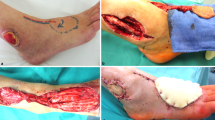Abstract
Background
Major amputation for advanced soft tissue loss with bone and tendon exposure, can be prevented in diabetes patients with a combined arterial reconstruction and free-flap transfer. We reviewed our 15-year outcome and evaluated the feasibility to save diabetic feet by means of this aggressive strategy.
Methods
A total of 55 type II diabetes patients (42–80 years of age), hospitalized between January 1992 and December 2006 for a combined arterial reconstruction and free-flap transfer, were followed until December 2007. All would have otherwise required at least a below-knee amputation. Arterial reconstructions, preferentially with autologous vein, were performed in combination with free tissue transfer, simultaneously or staged. The rectus abdominis muscle was the most frequently used muscle graft, although in recent years a growing number of alternative muscle and perforator flaps were used.
Results
The mean follow-up was 22 months (range: 1–180 months). Major complications occurred in 37% with only one in-hospital death. Major amputations were performed in 15 patients, 5 in the early postoperative period. The 1-year and 3-year limb salvage rates were 75.8 and 64.3%, with a 1-year and 3-year amputation-free survival of 69.5% and 55.8%. The 1-year and 3-year secondary patency for graft and free flap was 78.7% and 60.2%, respectively. Renal insufficiency was a major risk factor for limb loss (Hazard Ratio [HR] 5.581 (95% Confidence Interval [CI] 1.384–22.5)). Independent ambulation was regained in 38 patients.
Conclusions
Combined arterial reconstruction and free tissue transfer provides an excellent long-term result with regard to amputation-free survival and limb salvage. It should be considered in every diabetes patient with extensive soft tissue deficits before amputation is performed.





Similar content being viewed by others
References
Jude EB, Oyibo SO, Chalmers N et al (2001) Peripheral arterial disease in diabetic and nondiabetic patients: a comparison of severity and outcome. Diabetes Care 24:1433–1437
Malmstedt J, Leander K, Wahlberg E et al (2008) Outcome after leg bypass surgery for critical limb ischemia is poor in patients with diabetes: a population-based cohort study. Diabetes Care 31:887–892
Luther M (1994) The influence of arterial reconstructive surgery on the outcome of critical leg ischaemia. Eur J Vasc Surg 8:682–689
Inderbitzi R, Buettiker M, Enzler M (2003) The long-term mobility and mortality of patients with peripheral arterial disease following bilateral amputation. Eur J Vasc Endovasc Surg 26:59–64
Norgren L, Hiatt WR, Dormandy JA et al (2007) Inter-society consensus for the management of peripheral arterial disease (TASC II). J Vasc Surg 45:S5–S67
Luther M (1997) Surgical treatment for chronic critical leg ischaemia: a 5 year follow-up of socioeconomic outcome. Eur J Vasc Endovasc Surg 13:452–459
Tukiainen E, Kallio M, Lepäntalo M (2006) Advanced leg salvage of the critically ischemic leg with major tissue loss by vascular and plastic surgeon teamwork—long-term outcome. Ann Surg 244:949–958
Czerny M, Trubel W, Zimpfer D et al (2004) Limb-salvage by femoro-distal bypass and free muscle flap transfer. Eur J Vasc Endovasc Surg 27:635–639
Moran SL, Illig KA, Green RM et al (2002) Free-tissue transfer in patients with peripheral vascular disease: a 10-year experience. Plast Reconstr Surg 109:999–1006
Quinones-Baldrich WJ, Kashyap VS, Taw MB et al (2000) Combined revascularization and microvascular free tissue transfer for limb salvage: a six-year experience. Ann Vasc Surg 14:99–104
Cronenwett JL, McDaniel MD, Zwolak RM et al (1989) Limb salvage despite extensive tissue loss-free tissue transfer combined with distal revascularization. Arch Surg 124:609–615
Oishi SN, Levin LS, Pederson WC (1993) Microsurgical management of extremity wounds in diabetics with peripheral vascular-disease. Plast Reconstr Surg 92:485–492
Karp NS, Kasabian AK, Siebert JW et al (1994) Microvascular free-flap salvage of the diabetic foot—a 5-year experience. Plast Reconstr Surg 94:834–840
Gooden MA, Gentile AT, Mills JL et al (1997) Free tissue transfer to extend the limits of limb salvage for lower extremity tissue loss. Am J Surg 174:644–649
McCarthy WJ, Matsumura JS, Fine NA et al (1999) Combined arterial reconstruction and free tissue transfer for limb salvage. J Vasc Surg 29:814–818
Illig KA, Moran S, Serletti J et al (2001) Combined free tissue transfer and infrainguinal bypass graft: an alternative to major amputation in selected patients. J Vasc Surg 33:17–22
Moran SL, Salgado CJ, Serletti JM (2004) Free tissue transfer in patients with renal disease. Plast Reconstr Surg 113:2006–2011
Serletti JM, Deuber MA, Guidera PM et al (1995) Atherosclerosis of the lower-extremity and free-tissue reconstruction for limb salvage. Plast Reconstr Surg 96:1136–1144
Verhelle NAC, Lemaire V, Nelissen X et al (2004) Combined reconstruction of the diabetic foot including revascularization and free-tissue transfer. J Reconstr Microsurg 20:511–517
Lepäntalo M, Tukiainen E (1996) Combined vascular reconstruction and microvascular muscle flap transfer for salvage of ischaemic legs with major tissue loss and wound complications. Eur J Vasc Endovasc Surg 12:65–69
Tukiainen E, Biancari F, Lepäntalo M (2000) Lower limb revascularization and free flap transfer for major ischemic tissue loss. World J Surg 24:1531–1536
VanLanduyt K, Vermassen F, Monstrey S et al (1996) Single-stage revascularization and free flap coverage in the treatment of ischemic lower limb lesions. Eur J Plast Surg 19:245–252
Vermassen FEG, van Landuyt K (2000) Combined vascular reconstruction and free flap transfer in diabetic arterial disease. Diabetes-Metabolism Res Rev 16:S33–S36
Author information
Authors and Affiliations
Corresponding author
Rights and permissions
About this article
Cite this article
Randon, C., Vermassen, F., Jacobs, B. et al. Outcome of Arterial Reconstruction and Free-Flap Coverage in Diabetic Foot Ulcers: Long-Term Results. World J Surg 34, 177–184 (2010). https://doi.org/10.1007/s00268-009-0250-9
Published:
Issue Date:
DOI: https://doi.org/10.1007/s00268-009-0250-9




